Hydrothermal Alteration Zones’ Magnetic Susceptibility Footprints and 3D Model of Iron Oxide-Copper-Gold (IOCG) Mineralization, Carajás Mineral Province, Brazil
Abstract
1. Introduction
2. Geological Setting
2.1. Iron Oxide-Copper-Gold (IOCG) Deposits
2.2. Furnas Deposit Geological Setting
2.3. Hydrothermal Alteration and Mineralization
3. Materials and Methods
4. Results
4.1. Geophysical Magnetometry Data
4.1.1. Magnetic Anomaly
4.1.2. Induced Magnetization Inversion
4.2. Hydrothermal Alteration Zones Magnetic Susceptibility
4.2.1. Host Rocks
4.2.2. Hydrothermal Alteration Zones Footprints
4.2.3. Magnetic Hydrothermal Alteration Zones Footprints
4.2.4. Multiple Hydrothermal Alteration Zones Magnetic Susceptibility Footprints
4.3. Magnetic Susceptibility Footprints Interpretation
4.4. Magnetic Susceptibility 3D Modeling
5. Conclusions
Author Contributions
Funding
Data Availability Statement
Acknowledgments
Conflicts of Interest
Appendix A
Appendix A.1. Host Rocks
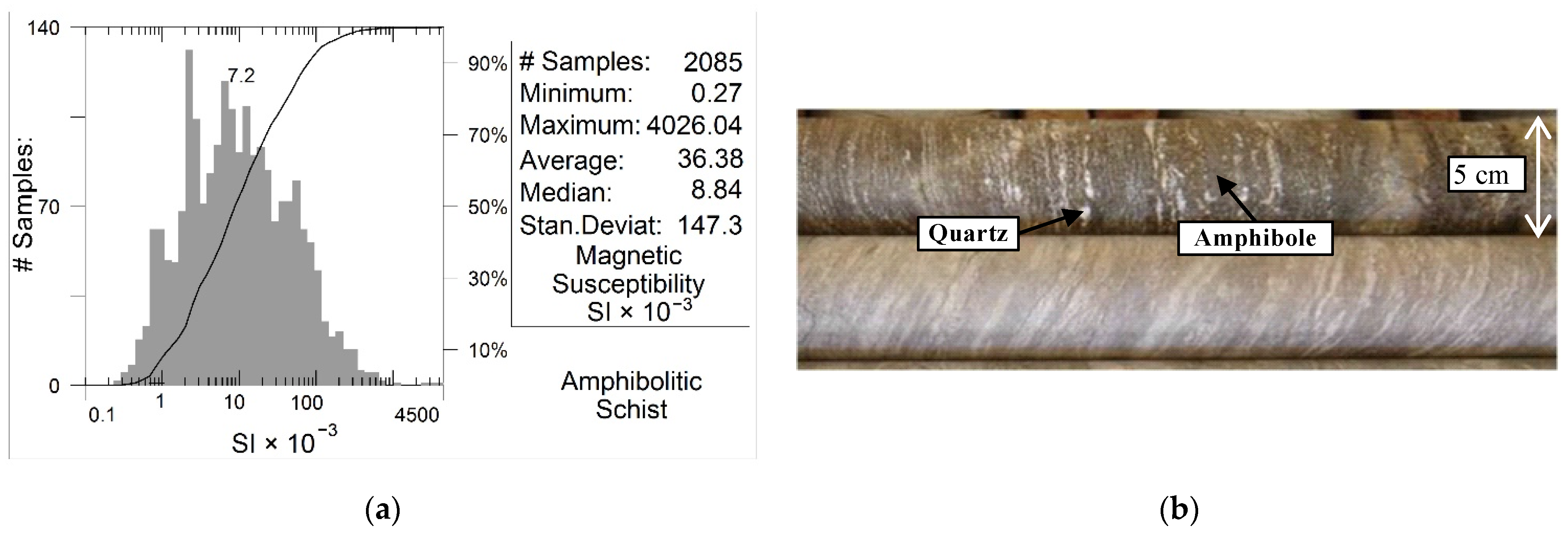
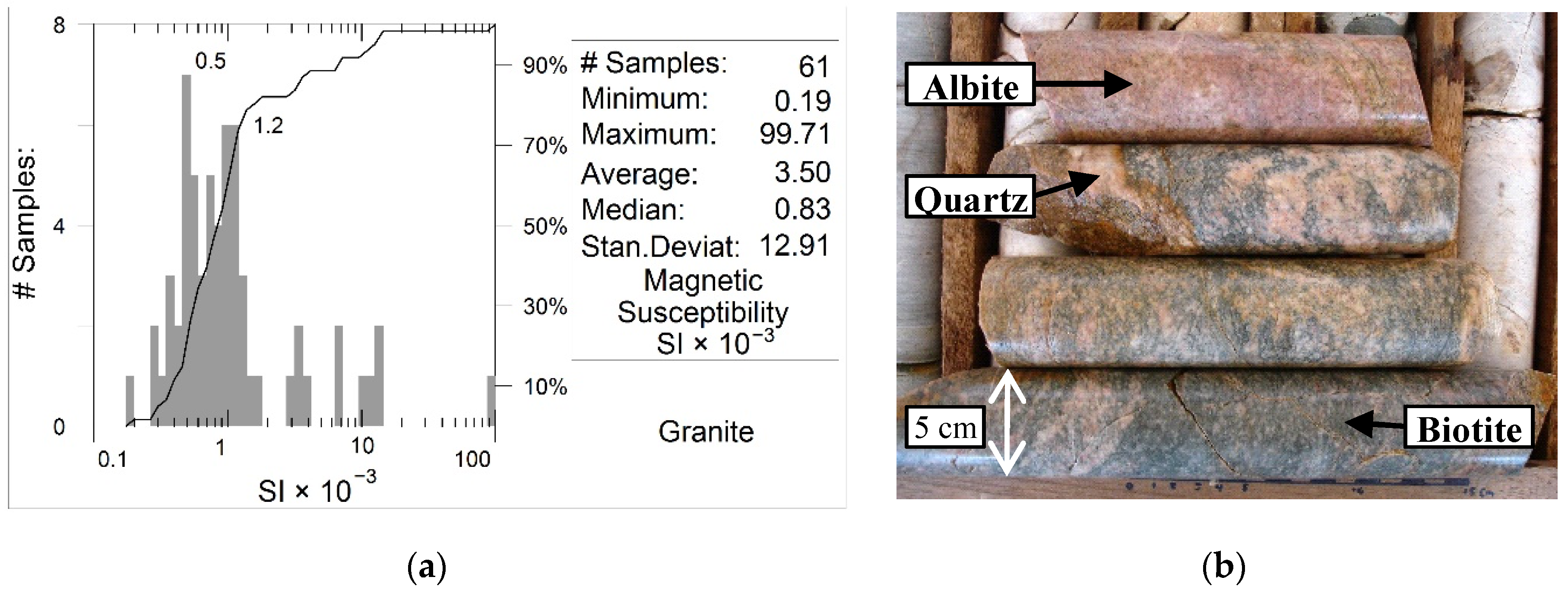
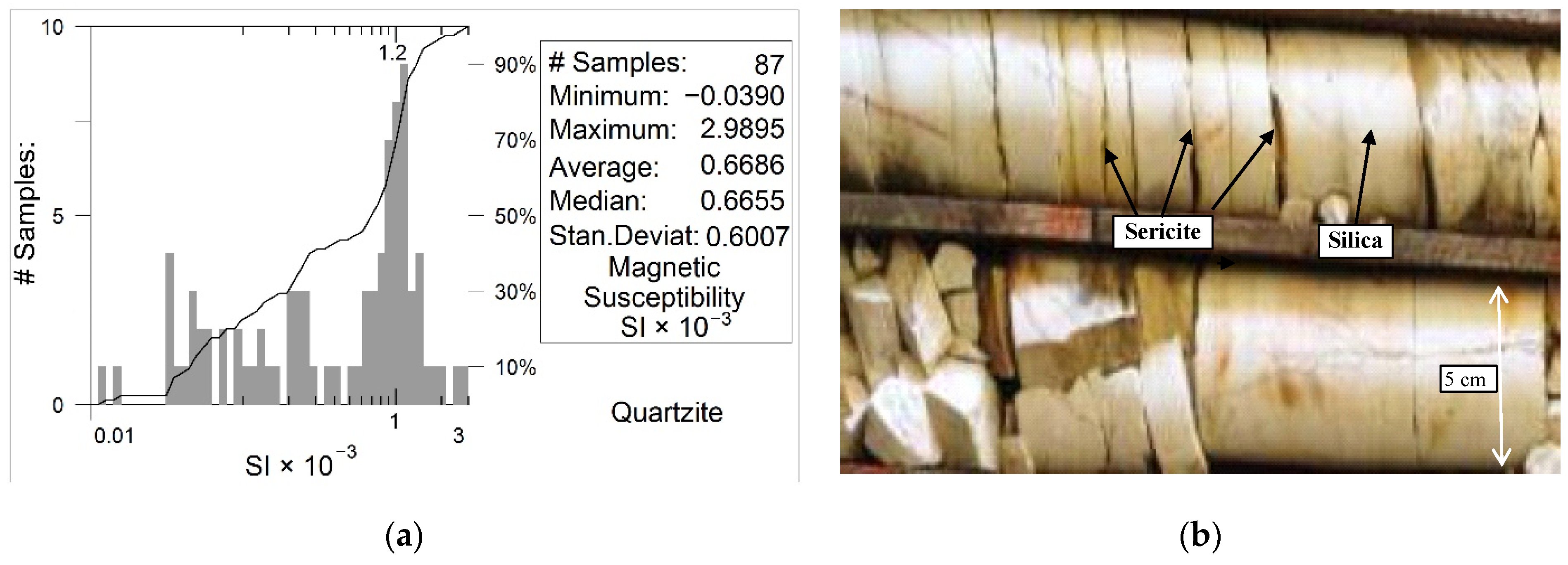
Appendix A.2. Hydrothermal Alteration Zones

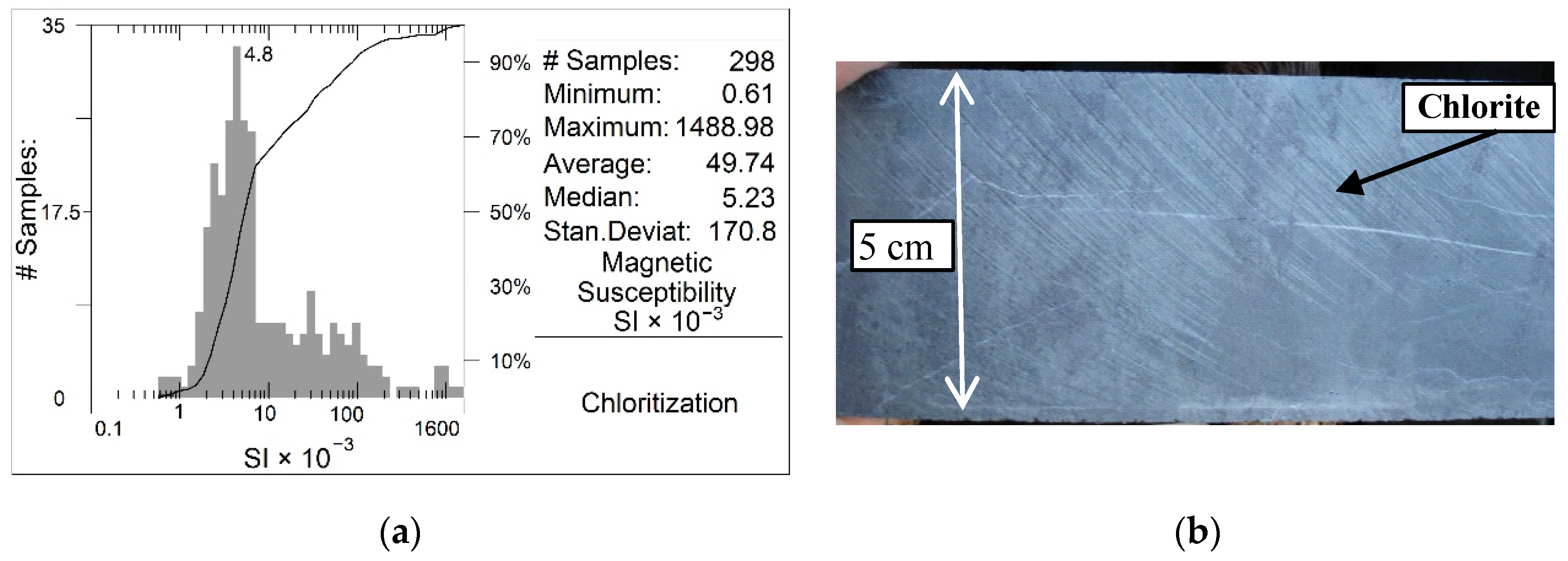
References
- Clark, D.A.; French, D.H.; Lackie, M.A.; Schmidt, P.W. Magnetic petrology: Application of integrated rock magnetic and petrological techniques to geological interpretation of magnetic surveys. Explor. Geophys. 1992, 23, 65–68. [Google Scholar] [CrossRef]
- Clark, D.A. Magnetic petrophysics and magnetic petrology: Aids to geological interpretation of magnetic surveys. J. Aust. Geol. Geophys. 1997, 17, 83–103. Available online: http://hdl.handle.net/102.100.100/224915?index=1 (accessed on 15 June 2021).
- Clark, D.A. Magnetic petrology of igneous intrusions: Implications for exploration and magnetic interpretation. Explor. Geophys. 1999, 30, 5–26. [Google Scholar] [CrossRef]
- Smith, R.J. Geophysics of iron oxide-copper-gold deposits. In Hydrothermal Iron Oxide-Copper-Gold and Related Deposits: A Global Perspective; Porter, T.M., Ed.; PGC Publishing: Adelaide, Australia, 2002; Volume 2, pp. 357–367. [Google Scholar]
- Sandrin, A.; Elming, S. Physical properties of rocks from borehole TJ71305 and geophysical outline of the Tjårrojåkka Cu-prospect, northern Sweden. Ore Geol. Rev. 2007, 30, 56–73. [Google Scholar] [CrossRef]
- Sandrin, A.; Edfelt, Å.; Waight, T.E.; Berggren, R.; Elming, S. Physical properties and petrologic description of rock samples from an IOCG mineralized area in the northern Fennoscandian Shield, Sweden. J. Geochem. Explor. 2009, 103, 80–96. [Google Scholar] [CrossRef]
- Austin, J.R.; Schmidt, P.W.; Foss, C.A. Magnetic modeling of iron oxide copper-gold mineralization constrained by 3D multiscale integration of petrophysical and geochemical data. Cloncurry District, Australia. Interpretation 2013, 1, T63–T84. [Google Scholar] [CrossRef]
- Clark, D.A. Magnetic effects of hydrothermal alteration in porphyry copper and iron-oxide copper-gold systems: A review. Tectonophysics 2014, 624, 46–65. [Google Scholar] [CrossRef]
- Fabris, A.; Katona, L.; Reed, G.; Keeping, T.; Gordon, G.; Gouthas, G.; Swain, G. Mapping the Punt Hill IOCG system using geophysical, geochemical and spectral methods—An integrated approach. In Proceedings of the Australian Society of Exploration Geophysicists ASEG Conference, 25th, Adelaide, Australia, 20 August 2016; pp. 1–9. [Google Scholar] [CrossRef]
- Sun, J.; Li, Y. Multidomain petrophysically constrained inversion and geology differentiation using guided fuzzy c-means clustering. Geophysics 2015, 80, ID1–ID18. [Google Scholar] [CrossRef]
- Sun, J.; Li, Y. Joint inversion of multiple geophysical and petrophysical data using generalized fuzzy clustering algorithms. Geophys. J. Int. 2017, 208, 1201–1216. [Google Scholar] [CrossRef]
- Melo, A.T.; Sun, J.; Li, Y. Geophysical inversions applied to 3d geology characterization of an iron oxide copper-gold deposit in Brazil. Geophysics 2017, 82, K1–K13. [Google Scholar] [CrossRef]
- Melo, A.T. Integrated Quantitative Interpretation of Multiple Geophysical Data for Geology Differentiation. PhD Thesis, Colorado School of Mines, Golden, CO, USA, 2018. [Google Scholar]
- Costa, I.S.L.; Tavares, F.M.; Oliveira, J.K.M. Predictive lithological mapping through machine learning methods: A case study in the Cinzento lineament, Carajás province, Brazil. J. Geol. Surv. Braz. 2019, 2, 26–36. [Google Scholar] [CrossRef]
- Melo, A.T.; Li, Y.; Hitzman, M. Is there hidden potential in Carajás? Insights through the geophysical signature of Cristalino deposit. Ore Geol. Rev. 2020, 126, 1–13. [Google Scholar] [CrossRef]
- Martins, T.F.; Seoane, J.C.S.; Tavares, F.M. Cu-Au exploration target generation in the eastern Carajás Mineral Province using random forest and multi-class index overlay mapping. J. South Am. Earth Sci. 2022, 116, 103790. [Google Scholar] [CrossRef]
- Hitzman, M.W.; Oreskes, N.; Einaudi, M.T. Geological characteristics and tectonic setting of Proterozoic iron oxide (Cu-U-Au-REE) deposits. Precambrian Res. 1992, 58, 241–287. [Google Scholar] [CrossRef]
- Oreskes, N.; Einaudi, M.T. Origin of rare earth element enriched hematite breccias at the Olympic Dam Cu-U-Au-Ag deposit, Roxby Downs, South Australia. Econ. Geol. 1990, 85, 1–28. [Google Scholar] [CrossRef]
- Oreskes, N.; Einaudi, M.T. Origin of hydrothermal fluids at Olympic Dam: Preliminary results from fluid inclusion and stable isotopes. Econ. Geol. 1992, 87, 64–90. [Google Scholar] [CrossRef]
- Williams, P.J.; Barton, M.D.; Johnson, D.A.; Fontboté, L.; Haller, A.; Mark, G.; Oliver, N.H.S.; Marschik, R. Iron Oxide Copper-Gold Deposits: Geology, Space-Time Distribution, and Possible Modes of Origin. In Economic Geology; Society of Economic Geologists: Littleton, CO, USA, 2005; 100th Anniversary Volume, pp. 371–405. [Google Scholar] [CrossRef]
- Groves, D.I.P.; Bierlein, F.P.; Meinert, L.D.; Hitzman, M.W. Iron oxide copper-gold (IOCG) deposits through Earth history; implications for origin, lithospheric setting, and distinction from other epigenetic iron oxide deposits. Econ. Geol. 2010, 105, 641–654. [Google Scholar] [CrossRef]
- Barton, M.D. Iron Oxide(-Cu-Au-REE-P-Ag-U-Co) Systems. In Treatise on Geochemistry, 2nd ed.; Holland, H.D., Turekian, K.K., Eds.; Elsevier: Amsterdam, The Netherlands, 2014; Volume 13, pp. 515–541. [Google Scholar] [CrossRef]
- Logan, L.; Andersson, J.B.H.; Whitehouse, M.J.; Martinsson, O.; Bauer, T.E. Energy Drive for the Kiruna Mining District Mineral System(s): Insights from U-Pb Zircon Geochronology. Minerals 2022, 12, 875. [Google Scholar] [CrossRef]
- Skirrow, R.G. Iron oxide copper-gold (IOCG) deposits—A review (part 1): Settings, mineralogy, ore geochemistry and classification. Ore Geol. Rev. 2022, 140, 104569. [Google Scholar] [CrossRef]
- Mougeot, R.; Respaut, J.P.; Briqueu, L.; Ledru, P.; Milesi, J.P.; Lerouge, C.; Marcoux, E.; Huhn, S.B.; Macambira, M.J.B. Isotope Geochemistry Constrains for Cu, Au Mineralization and Evolution of the Carajas Province (Para, Brazil). In Proceedings of the 39th Congresso Brasileiro de Geologia, Salvador, Brazil, 1–6 September 1996; Volume 7, pp. 321–324. [Google Scholar]
- Monteiro, L.V.S.; Xavier, R.P.; Carvalho, E.R.; Hitzman, M.W.; Johnson, C.A.; Filho, C.R.S.; Torresi, I. Spatial and temporal zoning of hydrothermal alteration and mineralization in the Sossego iron oxide-copper-gold deposit, Carajás Mineral Province, Brazil: Paragenesis and stable isotope constraints. Miner. Depos. 2008, 43, 129–159. [Google Scholar] [CrossRef]
- Xavier, R.P.; Monteiro, L.V.S.; Moreto, C.P.N.; Pestilho, A.L.S.; Melo, G.H.C.; Silva, M.A.D.; Aires, B.; Ribeiro, C.; Silva, F.H.F. The iron oxide copper-gold systems of the Carajás Mineral Province, Brazil. In Geology and Genesis of Major Copper Deposits and Districts of the World, 1st ed.; Hedenquist, J.W., Harris, M., Camus, F., Eds.; Society of Economic Geologists: Littleton, CO, USA, 2012; Special Publication Number 16; pp. 433–454. [Google Scholar] [CrossRef]
- Campo-Rodríguez, Y.T.; Schutesky, M.E.; Oliveira, C.G.; Whitehouse, M.J. Unveiling the polyphasic evolution of the Neoarchean IOCG Salobo deposit, Carajás Mineral Province, Brazil: Insights from magnetite trace elements and sulfur isotopes. Ore Geol. Rev. 2022, 140, 104572. [Google Scholar] [CrossRef]
- Huang, X.W.; Beaudoin, G.; Yang, Y. A HR-TEM study on two generations of magnetite from the Alemao IOCG deposit, Carajás, Brazil: Implication for Fe-Cu mineralization. Ore Geol. Rev. 2022, 146, 104934. [Google Scholar] [CrossRef]
- Corriveau, L.; Mumin, A.H.; Setterfield, T. IOCG environments in Canada: Characteristics, geological vectors to ore and challenges. In Hydrothermal Iron Oxide Copper-Gold and Related Deposits: A Global Perspective; Porter, T.M., Ed.; PGC Publishing: Adelaide, Australia, 2010; Volume 4, pp. 311–344. [Google Scholar]
- Corriveau, L.; Williams, P.J.; Mumin, A.H. Alteration vectors to IOCG mineralization: From uncharted terranes to deposits. In Exploring for Iron Oxide Copper-Gold Deposits: Canada and Global Analogues; Corriveau, L., Mumin, A.H., Eds.; Short Course Notes; Geological Association of Canada: St. John’s, NL, Canada, 2010; Volume 20, pp. 89–110. [Google Scholar]
- Corriveau, L.; Montreuil, J.F.; Potter, E.G. Alteration facies linkages among iron oxide copper-gold, iron oxide-apatite, and affiliated deposits in the Great Bear magmatic zone, Northwest Territories, Canada. Econ. Geol. 2016, 111, 2045–2072. [Google Scholar] [CrossRef]
- Santos, J.O.S.; Hartmann, L.A.; Gaudette, H.E.; Groves, D.I.; McNaughton, N.J.; Fletcher, I.R. A new understanding of the provinces of the Amazon Craton based on integration of field mapping and U-Pb and Sm-Nd geochronology. Gondwana Res. 2000, 3, 453–488. [Google Scholar] [CrossRef]
- Hirata, W.K.; Rigon, J.C.; Cordeiro, A.A.C.; Meireles, E.M. Geologia Regional da Província Mineral de Carajás. In Proceedings of the 1° Simpósio de Geologia da Amazônia SBG, Belém, Brazil, 25 May 1982; pp. 100–108. [Google Scholar]
- DOCEGEO. Revisão Litoestratigráfica da Província Mineral de Carajás. In Proceedings of the 35° Congresso Brasileiro de Geologia SBG, Belém, Brazil, 1 November 1988; pp. 11–56. [Google Scholar]
- Araújo, O.J.B.; Maia, R.G.N. Projeto Especial Mapas de Recursos Minerais, de Solos e de Vegetação para a Área do Programa Grande Carajás, Subprojeto Recursos Minerais, Folha SB.22-Z-A Serra dos Carajás-Estado do Pará; DNPM/CPRM: Brasília, Brazil, 1991; 136p. [Google Scholar]
- Barros, C.E.M.; Barbey, P. A importância da granitogênese tardi-arqueana (2.5 Ga.) na evolução tectono-metamórfica da Província Mineral de Carajás—O Complexo Granítico Estrela e sua auréola de contato. Rev. Bras. Geociênc. 1998, 28, 513–522. [Google Scholar] [CrossRef]
- Vasquez, M.L.; Sousa, C.S.; Carvalho, J.M.A. Mapa Geológico e de Recursos Minerais do Estado do Pará, Escala 1:1.000.000, Programa Geologia do Brasil (PGB). Serviço Geológico do Brasil: Brasília, Brazil, 2008. [Google Scholar]
- Wirth, K.R.; Gibbs, A.K.; Olszewski, W.J. U-Pb ages of zircons from the Grão-Pará Group and Serra dos Carajás Granite, Pará, Brazil. Rev. Bras. Geociênc. 1986, 16, 195–200. [Google Scholar] [CrossRef]
- Lindenmayer, Z.G. Salobo Sequence, Carajás, Brazil: Geology, Geochemistry and Metamorphism. Ph.D. Thesis, University of Western Ontario, London, OT, Canada, 1990. [Google Scholar]
- Lindenmayer, Z.G.; Teixeira, J.B.G. Ore Genesis at the Salobo Copper Deposit, Serra dos Carajás. In Base Metal Deposits of Brazil; Silva, M.G., Misi, A., Eds.; MME/CPRM/DNPM: Brasília, Brazil, 1999; pp. 33–43. [Google Scholar]
- Vale, S.A. Projeto Furnas, Relatório Final de Geologia: Internal Technical Report; Vale: Parauapebas, Brazil, 2012. [Google Scholar]
- Leão-Santos, M.H.; Li, Y.; Moraes, R.A.V. Application of 3D magnetic amplitude inversion to Fe oxide-Cu-Au deposits at low magnetic latitudes: A case study from Carajás Mineral Province, Brazil. Geophysics 2015, 80, B13–B22. [Google Scholar] [CrossRef]
- Li, Y.; Oldenburg, D.W. 3-D inversion of magnetic data. Geophysics 1996, 61, 394–408. [Google Scholar] [CrossRef]
- Telford, W.M.; Geldart, L.P.; Sheriff, R.E. Applied Geophysics, 2nd ed.; Cambridge University Press: Cambridge, UK, 1990; 770 p. [Google Scholar]
- Seequent, Geosoft Oasis Montaj Software, 3D Kriging GX. Available online: https://www.seequent.com/ (accessed on 15 July 2021).
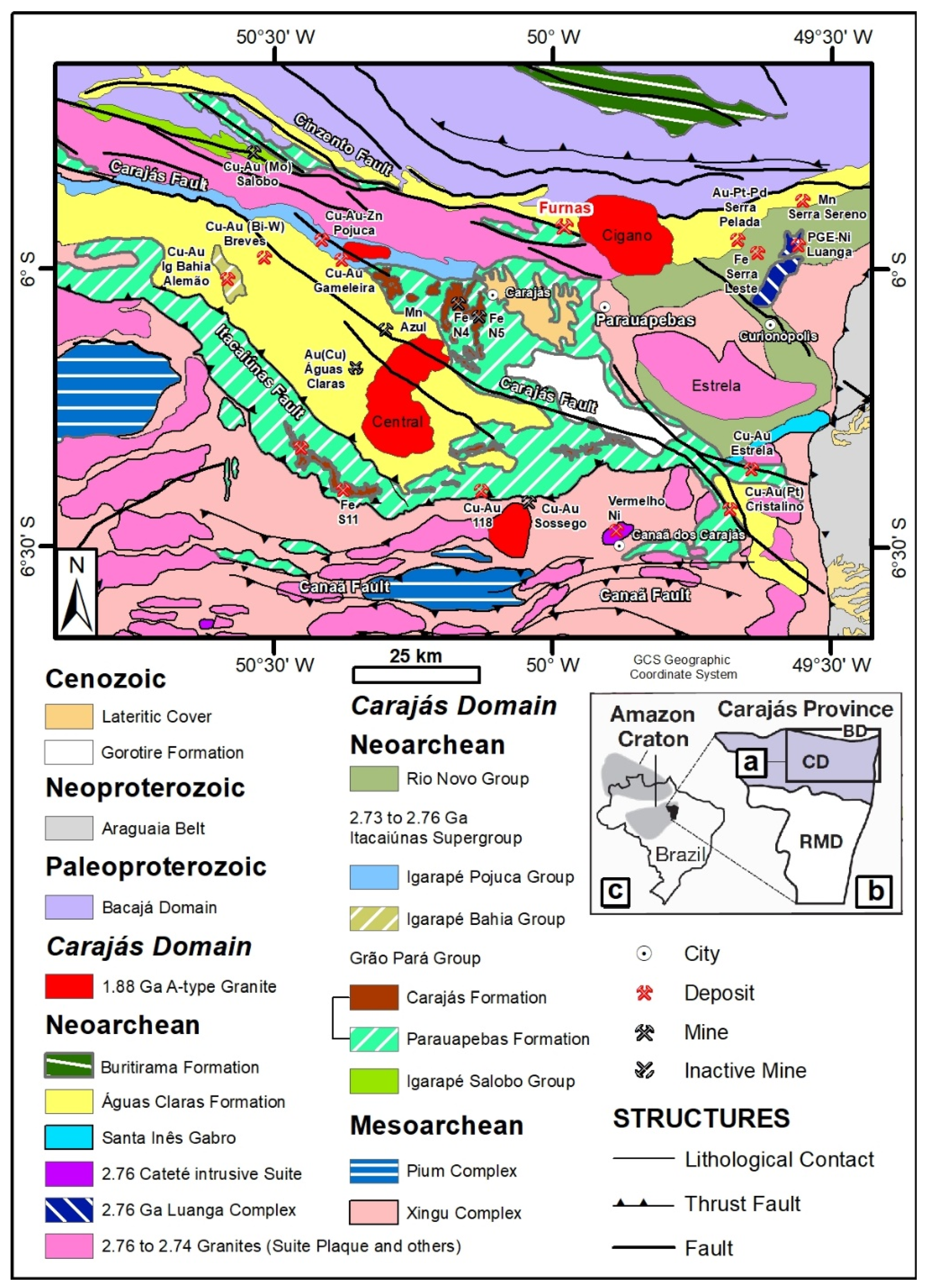
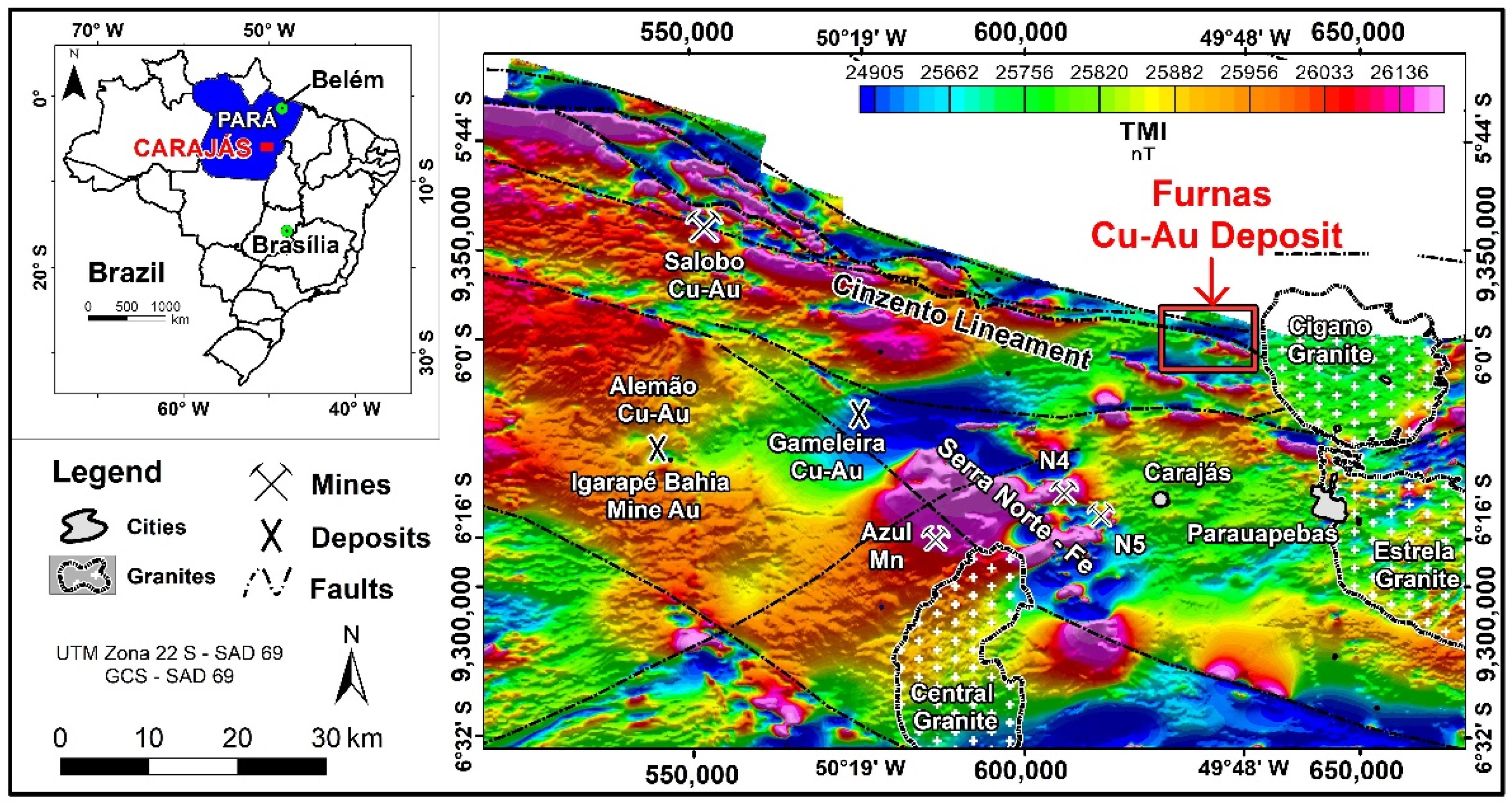
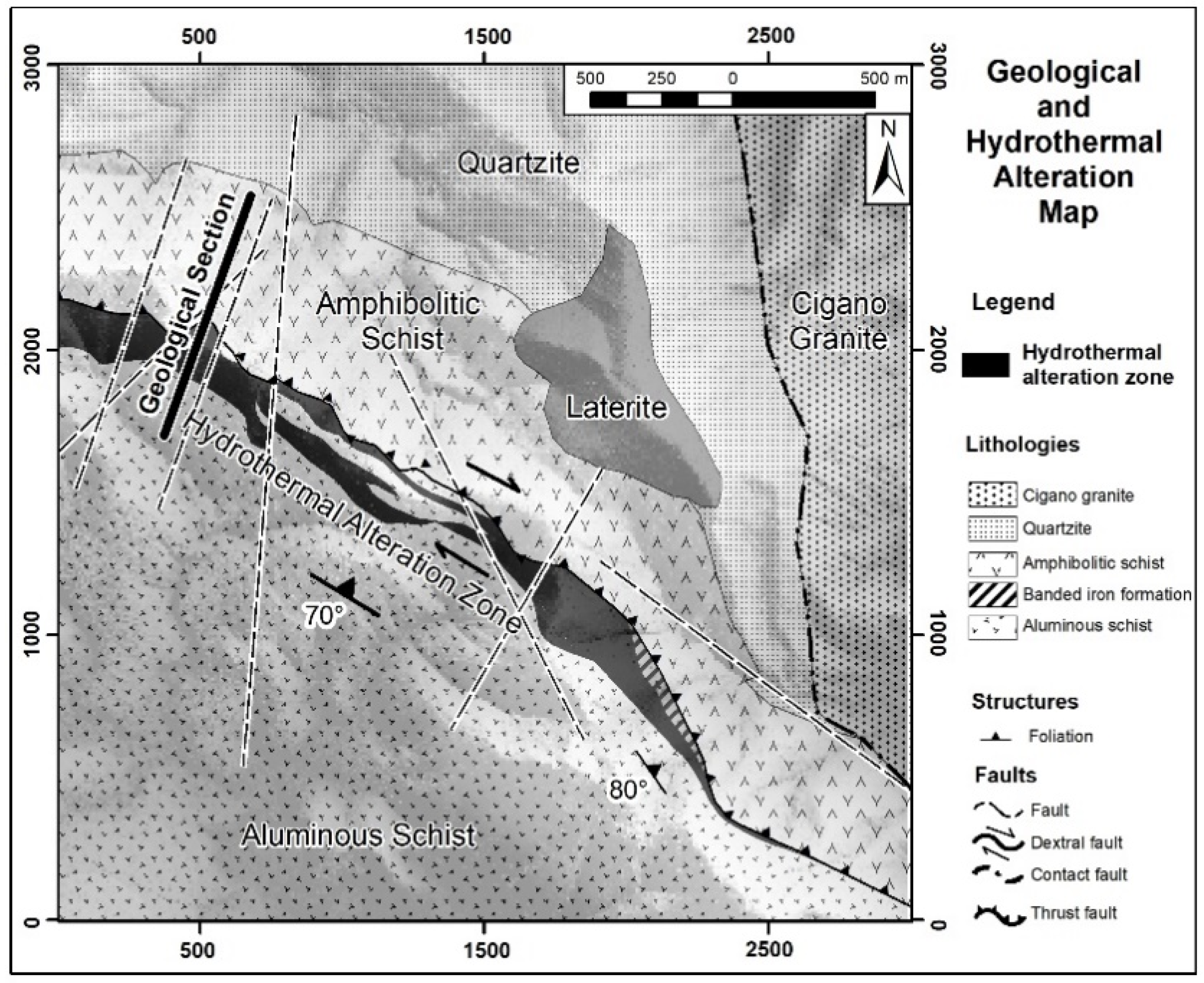


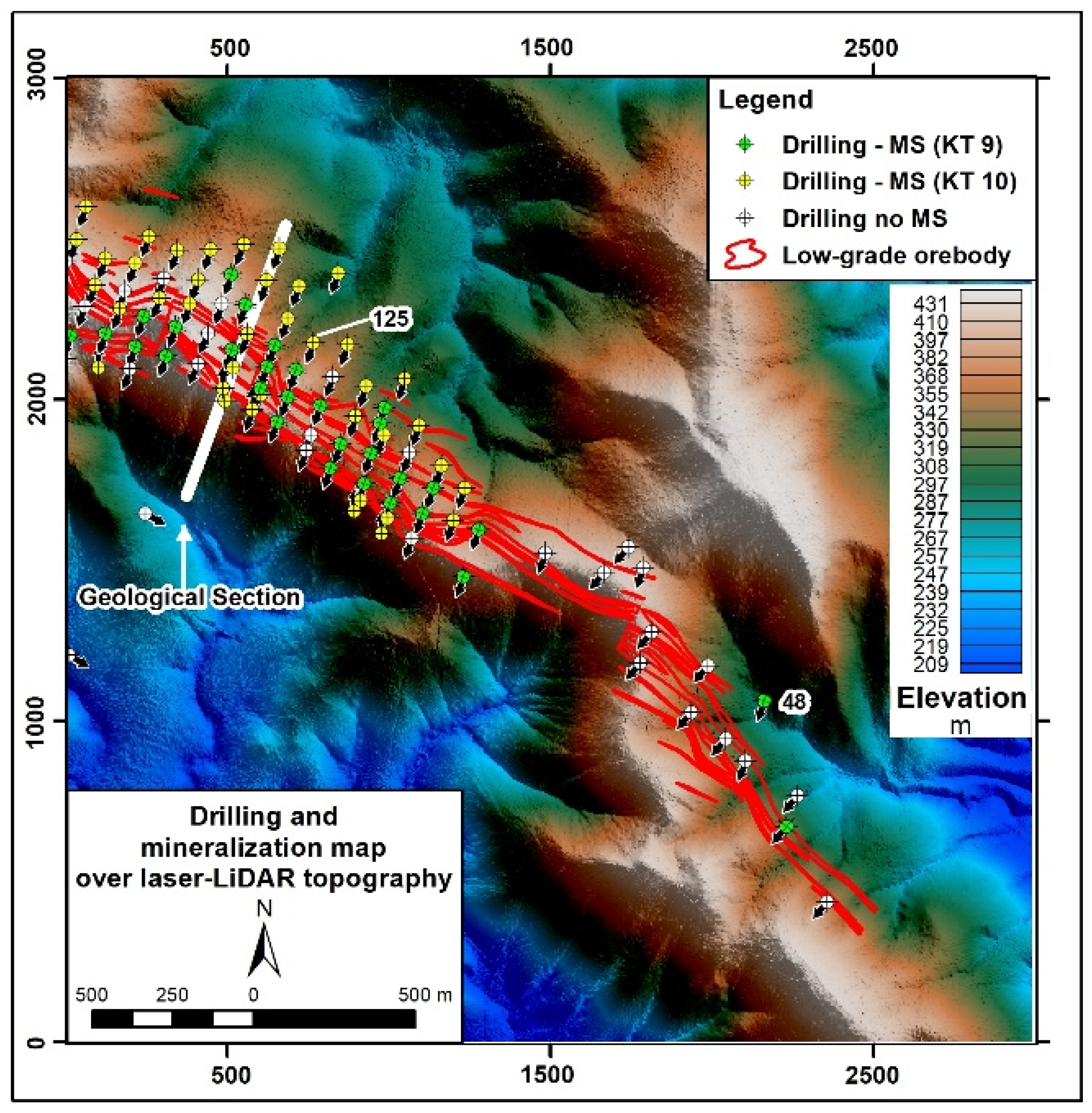
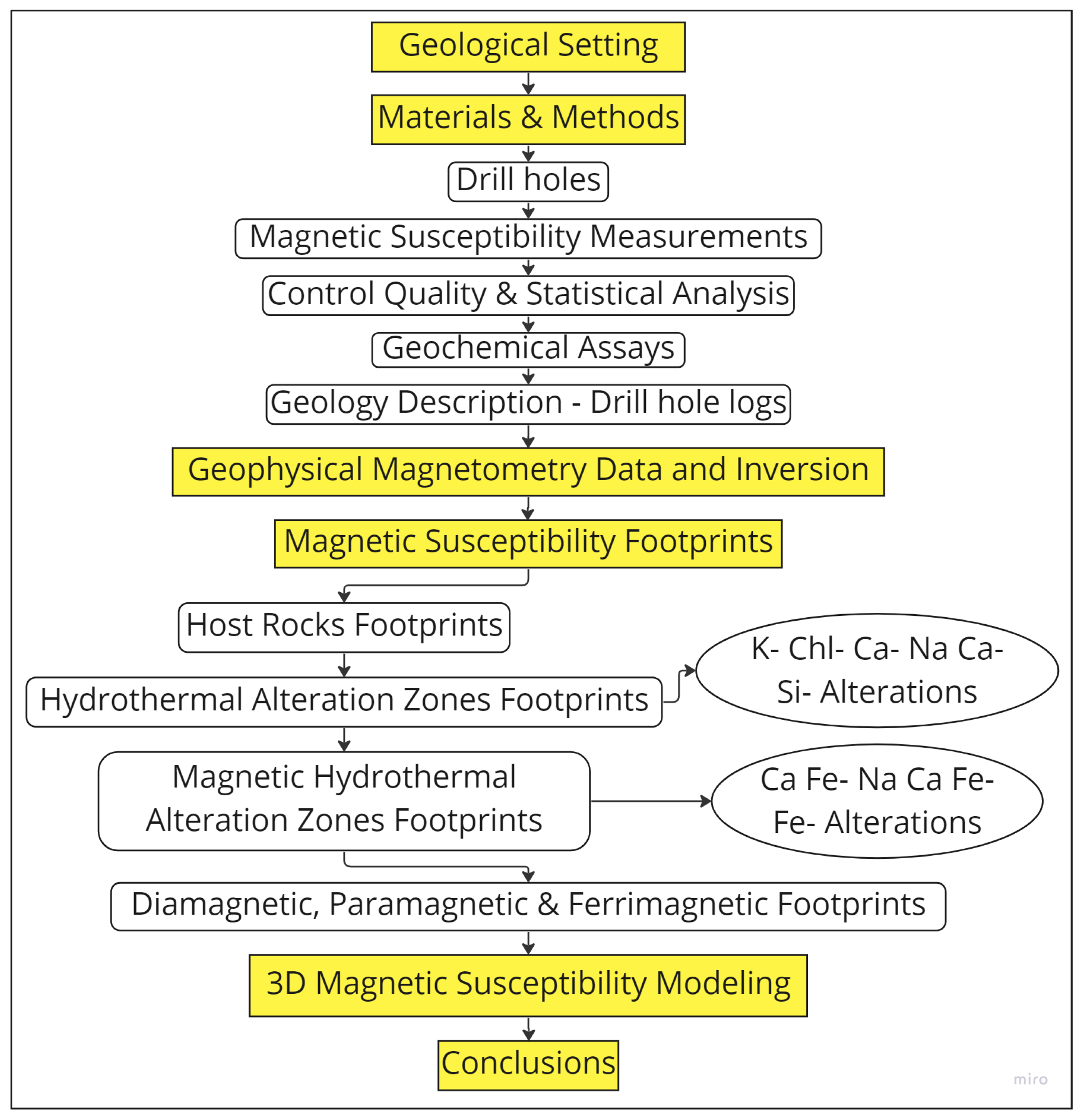

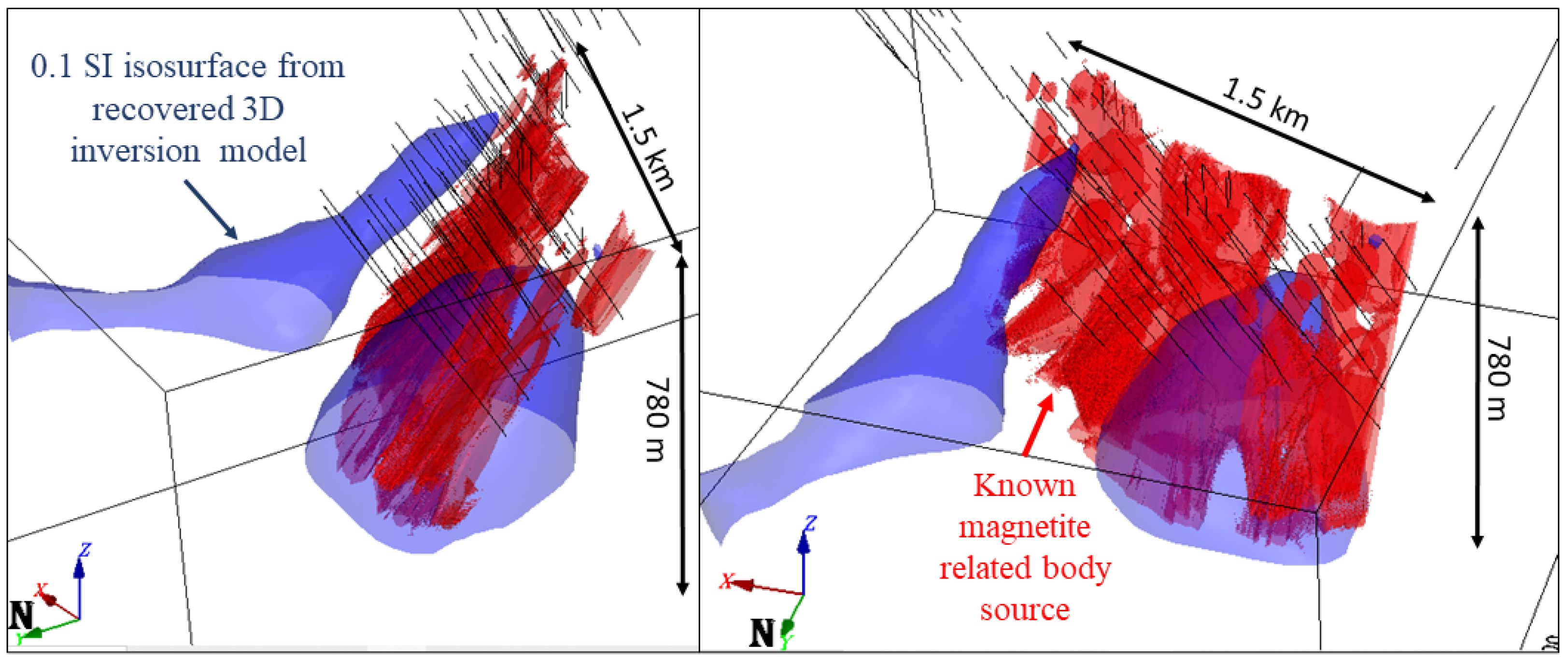
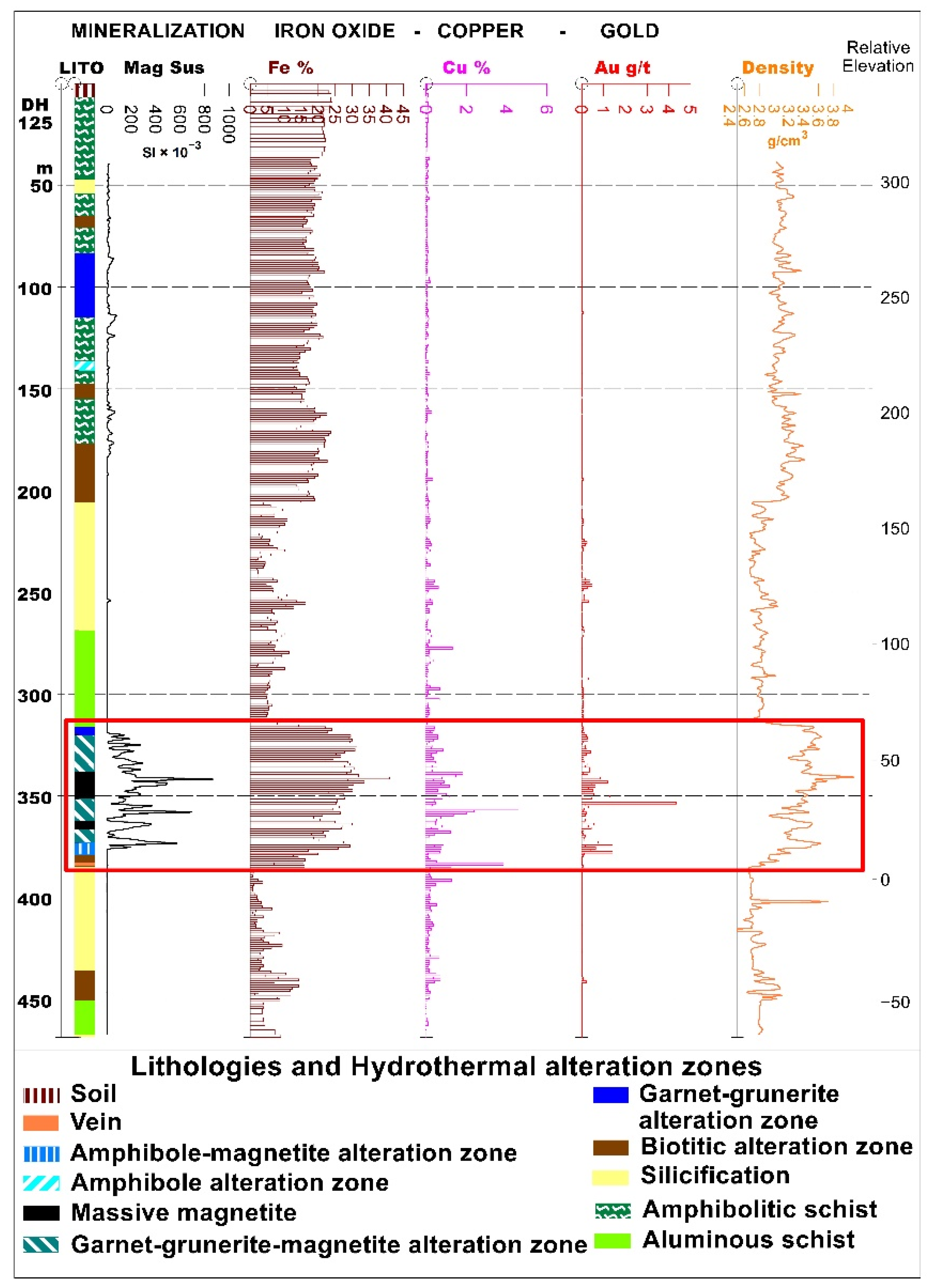
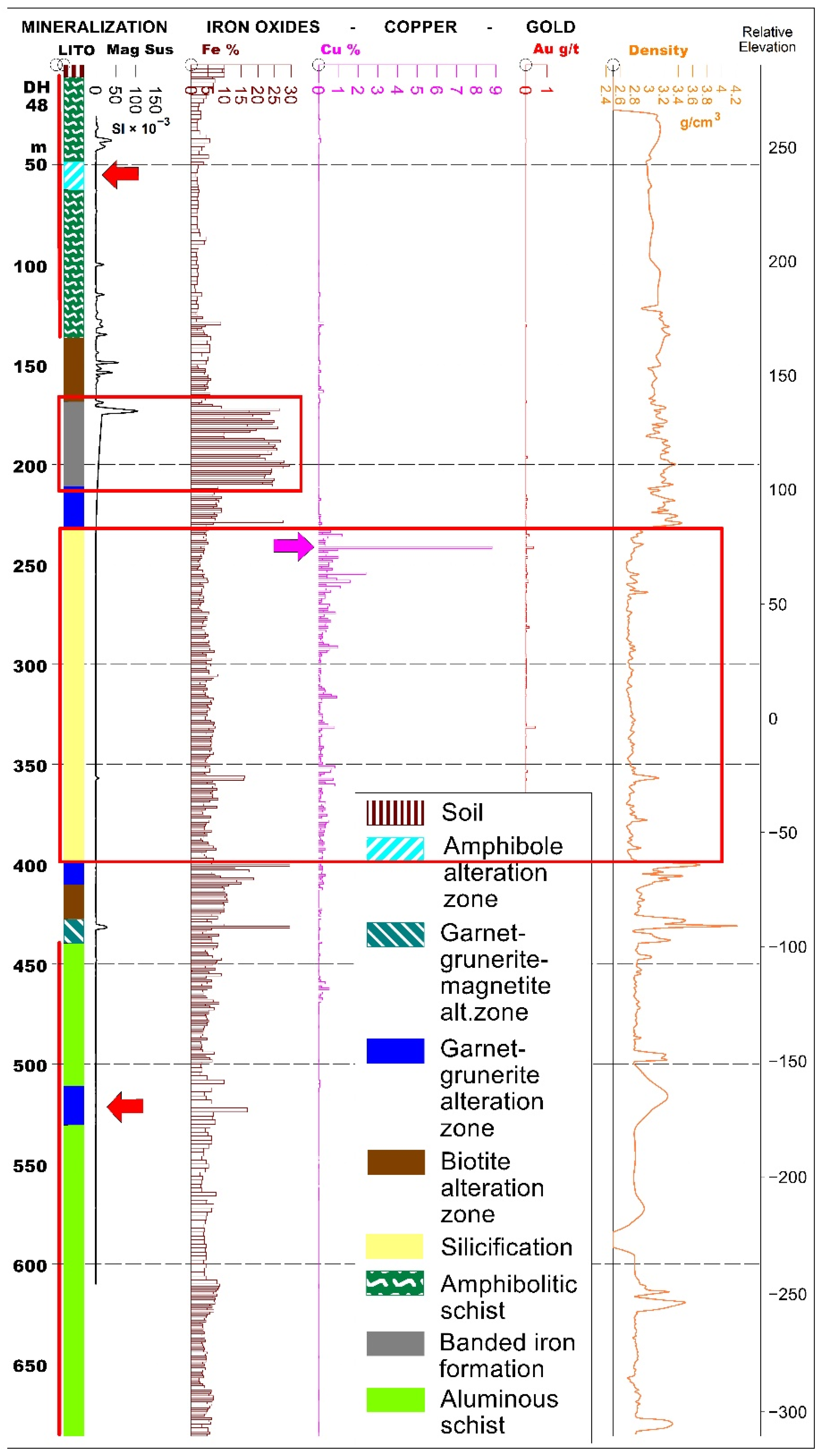
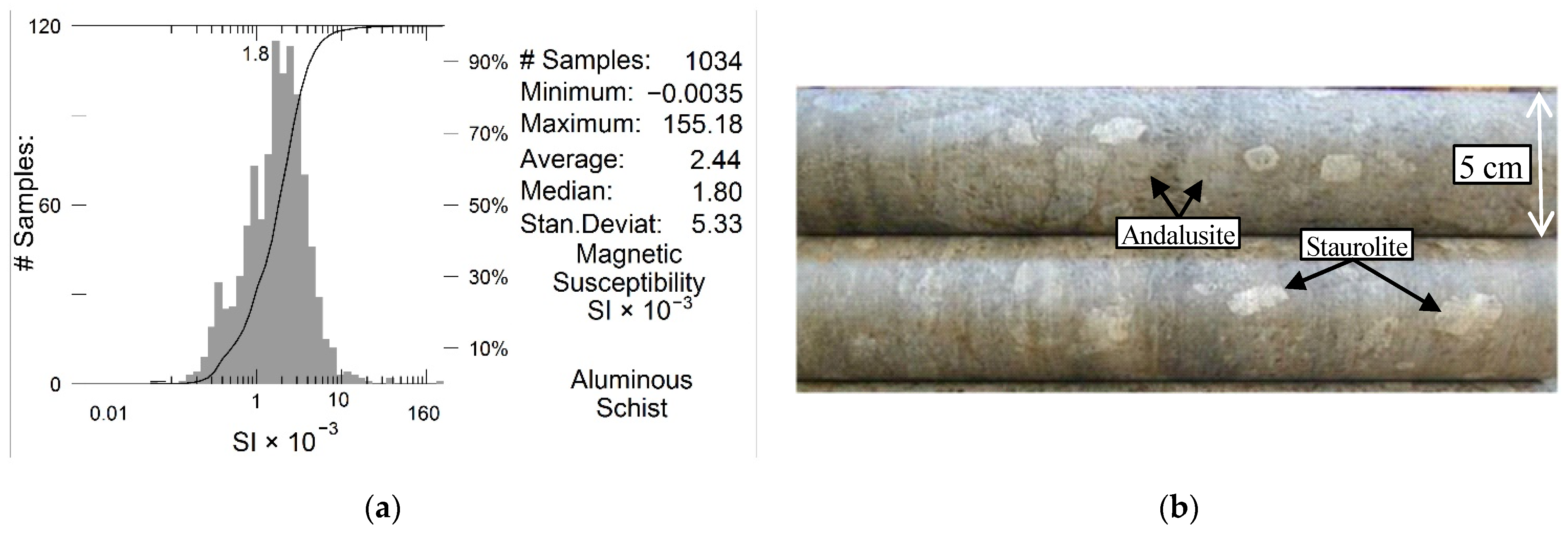
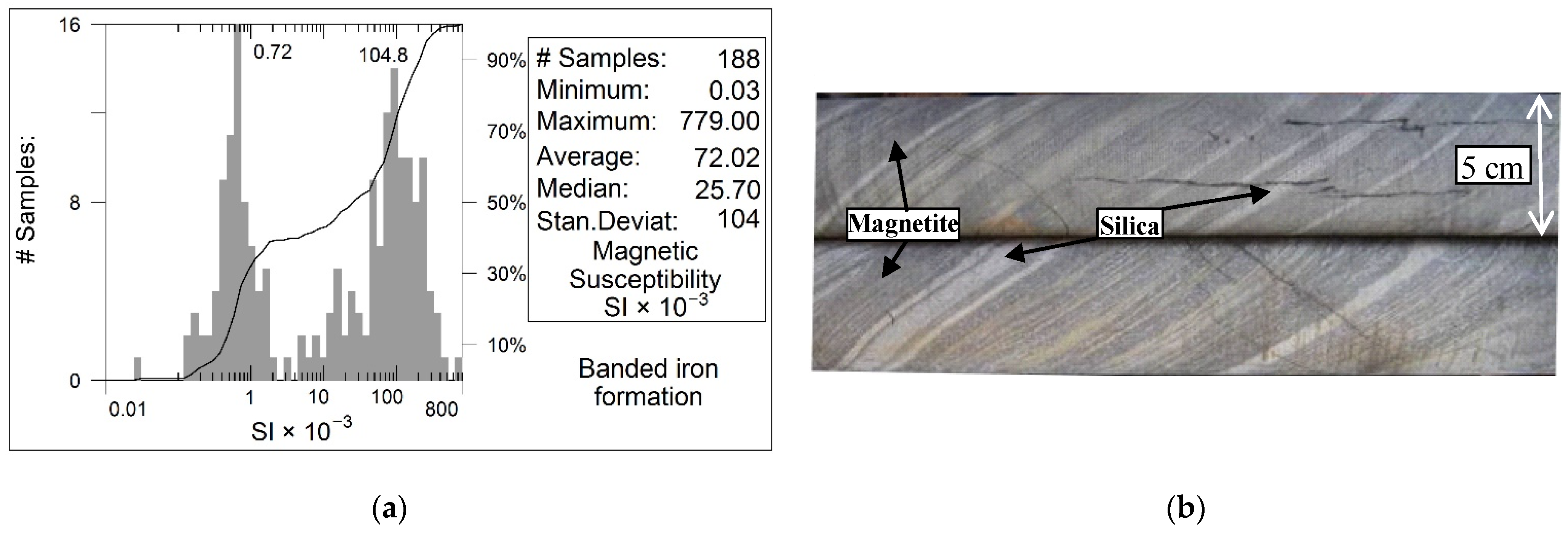
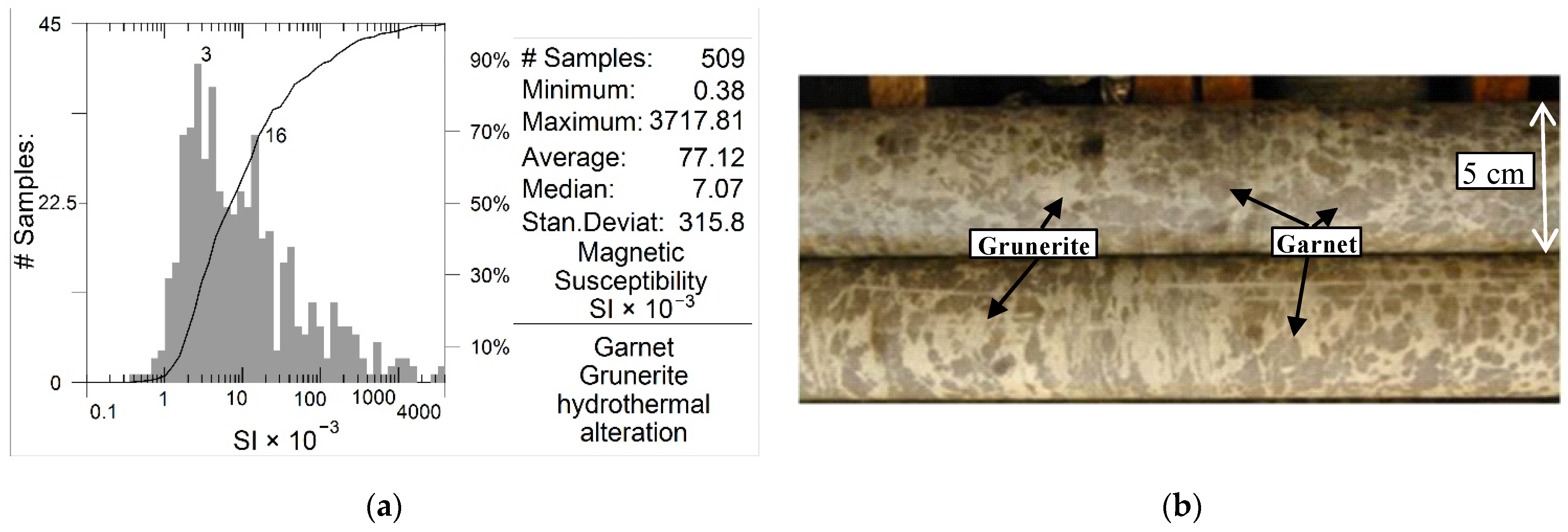
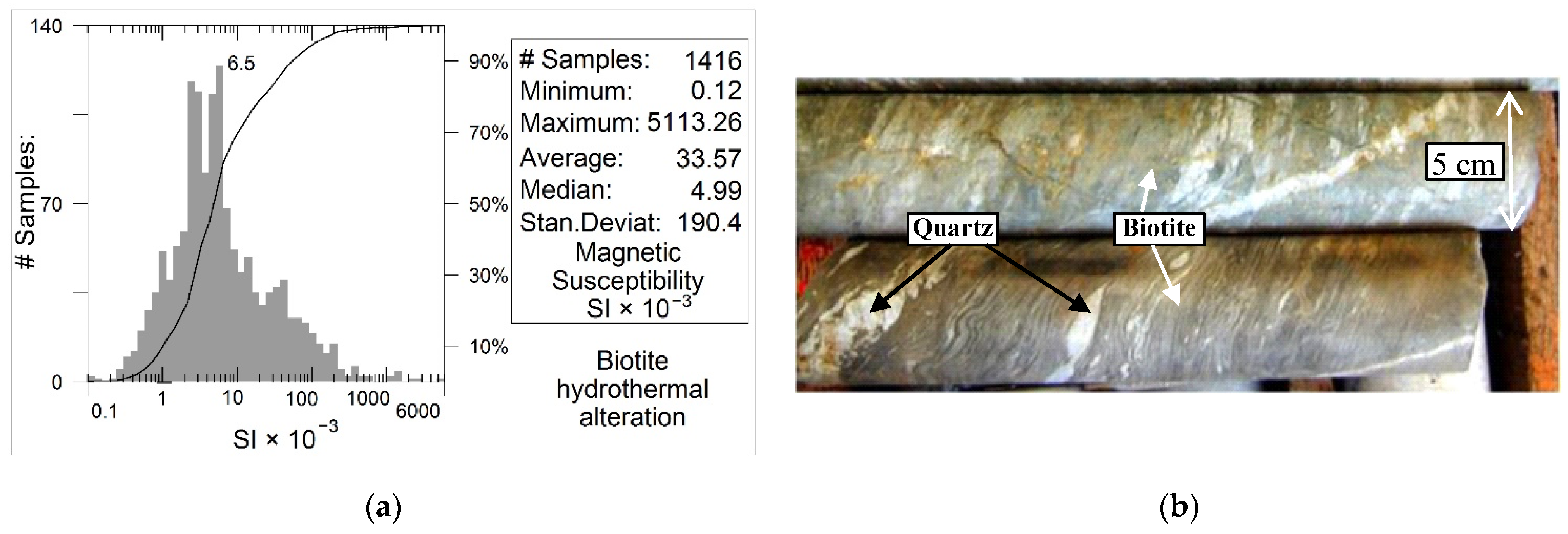


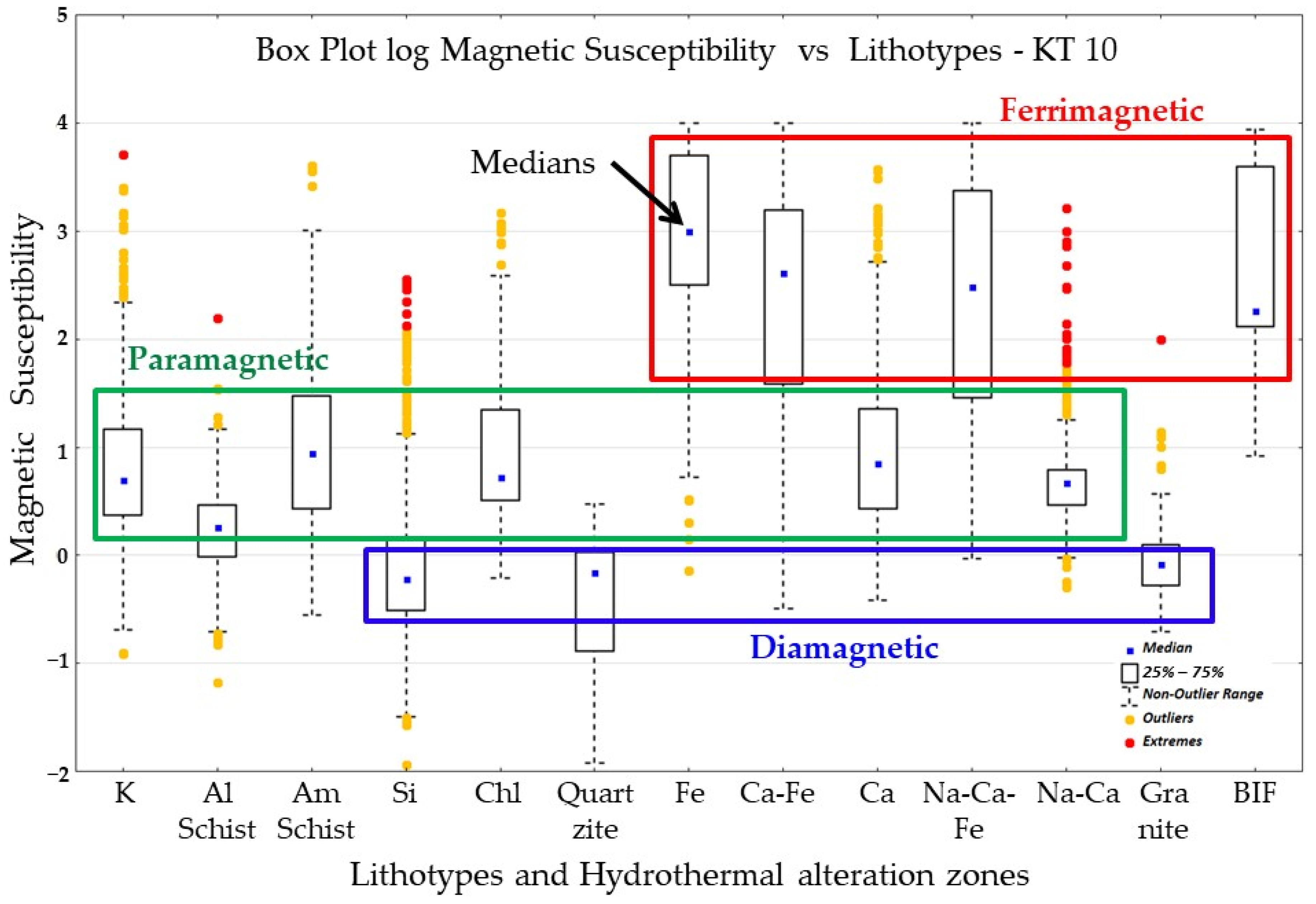
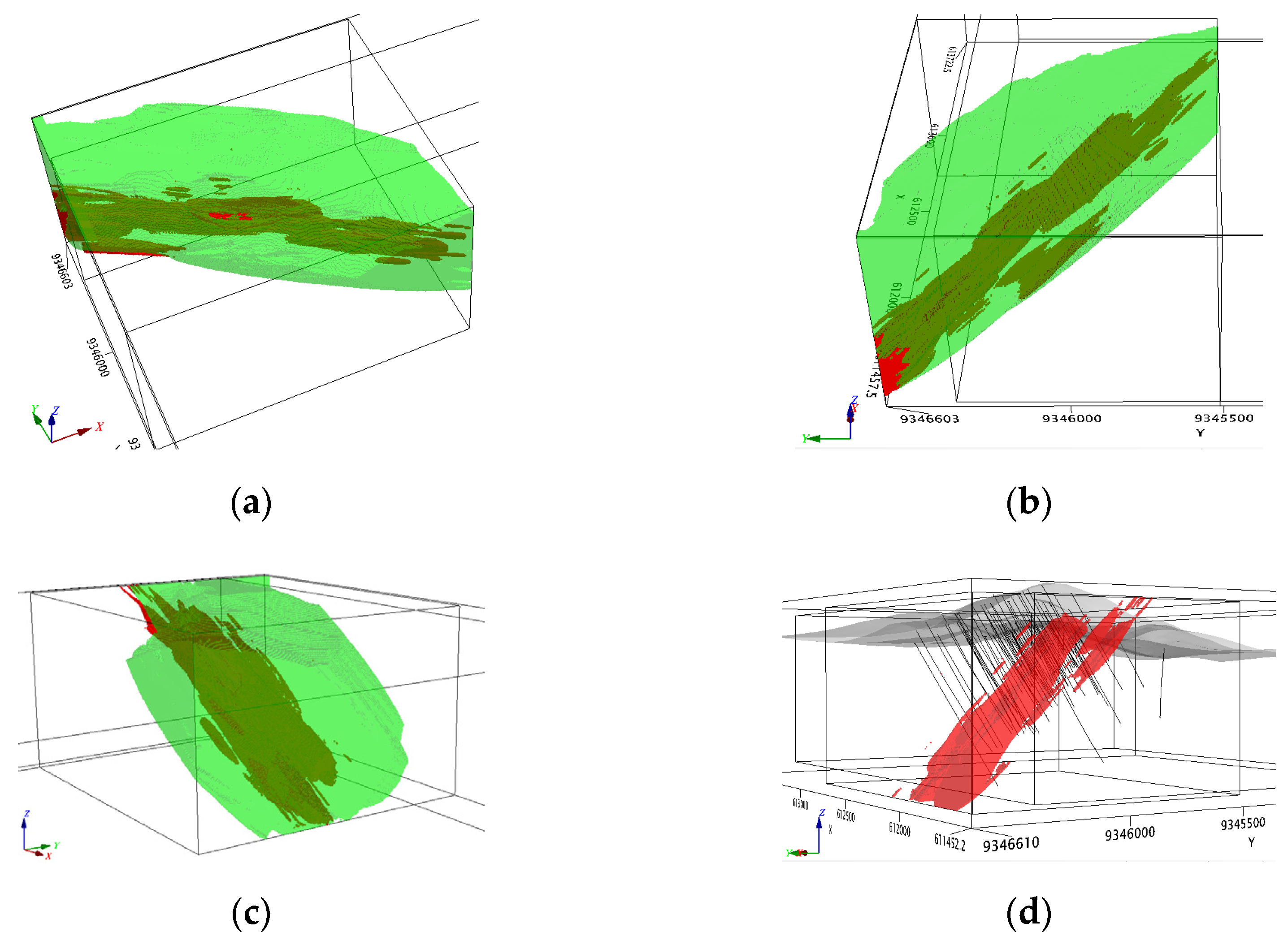

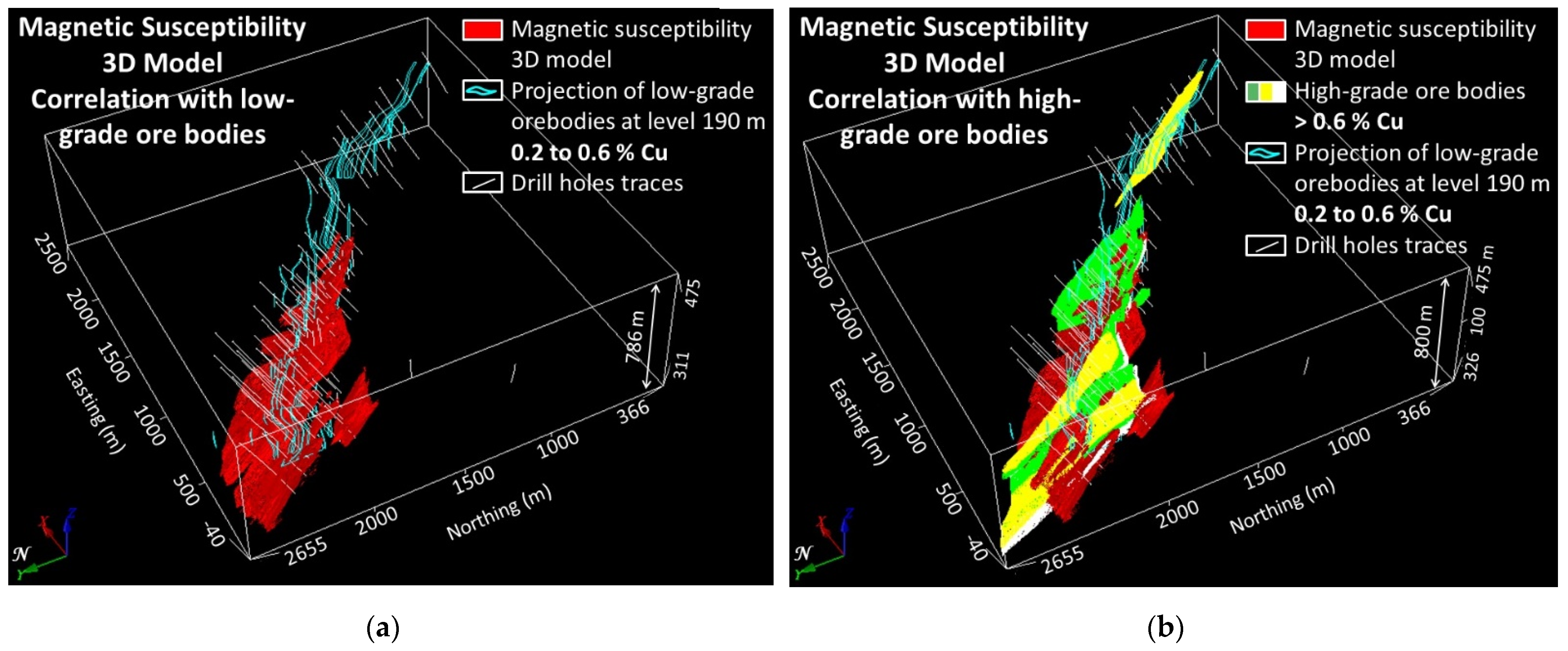
| Lithotypes | Alteration Type | Mineralogy (Petrography) | Med | Min | Max | |
|---|---|---|---|---|---|---|
| Ferrimagnetic | Massive magnetite hydrothermal alteration | Magnetite (Fe) | Magnetite ± amphibole (grunerite, actinolite, hornblende = hastingsite) ± quartz | 855 | 0.72 | 9251 |
| Garnet-grunerite-magnetite hydrothermal alteration | Calcic-magnetite (Ca-Fe) | Garnet (almandine), amphibole (grunerite), magnetite ± biotite ± chlorite | 395 | 0.32 | 9418 | |
| Amphibole-magnetite hydrothermal alteration | Sodic-calcic-magnetite (Na-Ca-Fe) | Amphibole (actinolite), magnetite ± garnet ± quartz ± biotite ± chlorite | 269 | 0.93 | 9296 | |
| Banded iron formation | Host rock | Magnetite, silica | 25.7 | 0.03 | 779 | |
| Paramagnetic | Garnet-grunerite hydrothermal alteration | Calcic (Ca) | Garnet (almandine), amphibole (grunerite) ± quartz ± chlorite ± biotite | 7 | 0.38 | 3717 |
| Amphibole hydrothermal alteration | Sodic-calcic (Na-Ca) | Amphibole (actinolite) ± quartz ± biotite ± chlorite | 4.64 | 0.51 | 1618 | |
| Chlorite alteration | Chloritization (Chl) | Chlorite | 5.23 | 0.61 | 1488 | |
| Biotite hydrothermal alteration | Potassic (K) | Biotite, quartz, plagioclase, phengite ± garnet | 4.9 | 0.12 | 5113 | |
| Amphibolitic schist | Host rock | Amphibole (grunerite), quartz ± hornblende = hastingsite | 8.84 | 0.27 | 4026 | |
| Aluminous schist | Host rock | Quartz, biotite, sericite, andalusite, staurolite, silimanite ± garnet ± chlorite | 1.8 | −0.003 | 155 | |
| Diamagnetic | Monzogranite | Host rock | Quartz, plagioclase, microcline, biotite, chlorite (±pegmatites, granophyres) | 0.83 | 0.19 | 99 |
| Quartzite | Host rock | Quartz ± sericite | 0.6 | −0.03 | 2.9 | |
| Silicification | Silicic (Si) | Silica, sericite | 0.6 | −0.04 | 357 |
Publisher’s Note: MDPI stays neutral with regard to jurisdictional claims in published maps and institutional affiliations. |
© 2022 by the authors. Licensee MDPI, Basel, Switzerland. This article is an open access article distributed under the terms and conditions of the Creative Commons Attribution (CC BY) license (https://creativecommons.org/licenses/by/4.0/).
Share and Cite
Leão-Santos, M.; Moraes, R.; Li, Y.; Raposo, M.I.; Zuo, B. Hydrothermal Alteration Zones’ Magnetic Susceptibility Footprints and 3D Model of Iron Oxide-Copper-Gold (IOCG) Mineralization, Carajás Mineral Province, Brazil. Minerals 2022, 12, 1581. https://doi.org/10.3390/min12121581
Leão-Santos M, Moraes R, Li Y, Raposo MI, Zuo B. Hydrothermal Alteration Zones’ Magnetic Susceptibility Footprints and 3D Model of Iron Oxide-Copper-Gold (IOCG) Mineralization, Carajás Mineral Province, Brazil. Minerals. 2022; 12(12):1581. https://doi.org/10.3390/min12121581
Chicago/Turabian StyleLeão-Santos, Marcelo, Roberto Moraes, Yaoguo Li, Maria Irene Raposo, and Boxin Zuo. 2022. "Hydrothermal Alteration Zones’ Magnetic Susceptibility Footprints and 3D Model of Iron Oxide-Copper-Gold (IOCG) Mineralization, Carajás Mineral Province, Brazil" Minerals 12, no. 12: 1581. https://doi.org/10.3390/min12121581
APA StyleLeão-Santos, M., Moraes, R., Li, Y., Raposo, M. I., & Zuo, B. (2022). Hydrothermal Alteration Zones’ Magnetic Susceptibility Footprints and 3D Model of Iron Oxide-Copper-Gold (IOCG) Mineralization, Carajás Mineral Province, Brazil. Minerals, 12(12), 1581. https://doi.org/10.3390/min12121581







